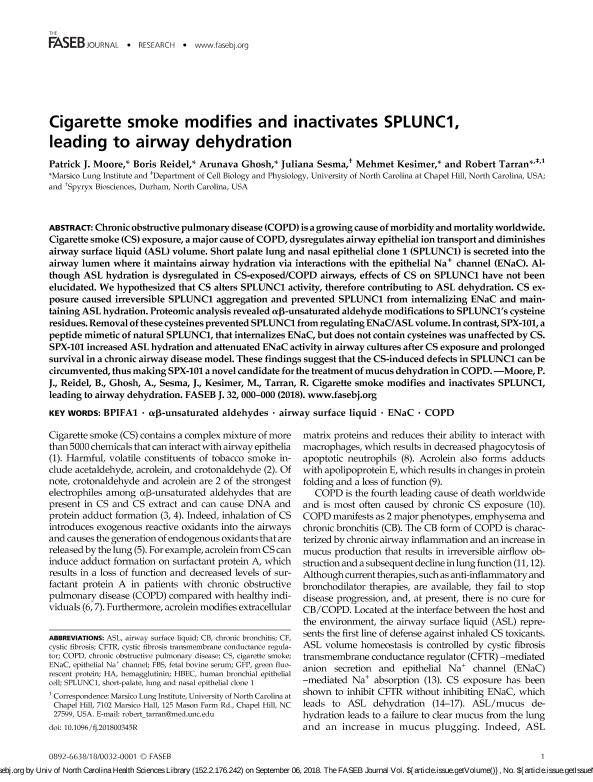Artículo
Cigarette smoke modifies and inactivates SPLUNC1, leading to airway dehydration
Fecha de publicación:
12/2018
Editorial:
Federation of American Societies for Experimental Biology
Revista:
FASEB Journal
ISSN:
0892-6638
Idioma:
Inglés
Tipo de recurso:
Artículo publicado
Clasificación temática:
Resumen
Chronic obstructive pulmonary disease (COPD) is a growing cause of morbidity and mortality worldwide. Cigarette smoke (CS) exposure, a major cause of COPD, dysregulates airway epithelial ion transport and diminishes airway surface liquid (ASL) volume. Short palate lung and nasal epithelial clone 1 (SPLUNC1) is secreted into the airway lumen where it maintains airway hydration via interactions with the epithelial Na1 channel (ENaC). Although ASL hydration is dysregulated in CS-exposed/COPD airways, effects of CS on SPLUNC1 have not been elucidated. We hypothesized that CS alters SPLUNC1 activity, therefore contributing to ASL dehydration. CS exposure caused irreversible SPLUNC1 aggregation and prevented SPLUNC1 from internalizing ENaC and maintaining ASL hydration. Proteomic analysis revealed ab-unsaturated aldehyde modifications to SPLUNC1’s cysteine residues. Removal of these cysteines prevented SPLUNC1 from regulating ENaC/ASL volume. In contrast, SPX-101, a peptide mimetic of natural SPLUNC1, that internalizes ENaC, but does not contain cysteines was unaffected by CS. SPX-101 increased ASL hydration and attenuated ENaC activity in airway cultures after CS exposure and prolonged survival in a chronic airway disease model. These findings suggest that the CS-induced defects in SPLUNC1 can be circumvented, thus making SPX-101 a novel candidate for the treatment of mucus dehydration in COPD.
Palabras clave:
AB-UNSATURATED ALDEHYDES
,
AIRWAY SURFACE LIQUID
,
BPIFA1
,
COPD
,
ENAC
Archivos asociados
Licencia
Identificadores
Colecciones
Articulos(CCT - ROSARIO)
Articulos de CTRO.CIENTIFICO TECNOL.CONICET - ROSARIO
Articulos de CTRO.CIENTIFICO TECNOL.CONICET - ROSARIO
Citación
Moore, Patrick J.; Reidel, Boris; Ghosh, Arunava; Sesma, Juliana; Kesimer, Mehmet; et al.; Cigarette smoke modifies and inactivates SPLUNC1, leading to airway dehydration; Federation of American Societies for Experimental Biology; FASEB Journal; 32; 12; 12-2018; 6559-6574
Compartir
Altmétricas




